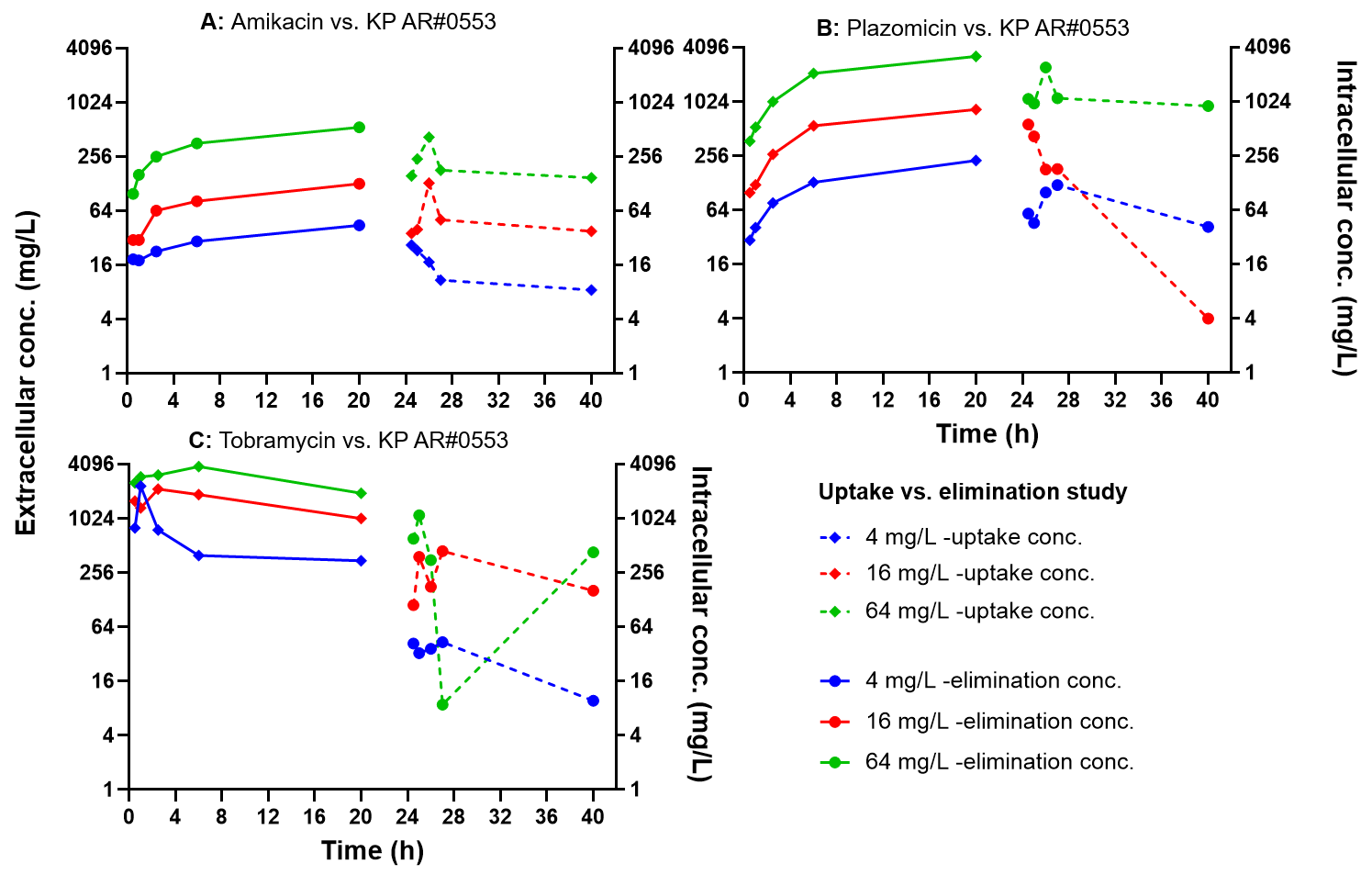Back
Purpose: Resistant bacterial pathogens are significantly jeopardizing the successful treatment of serious infections. MDR Klebsiella pneumoniae isolates are highly challenging. While AGS antibiotics play a critical role against this pathogen, their intracellular accumulation is poorly known. Therefore, we aimed to characterize the intracellular accumulation and washout kinetics of three AGS in MDR K. pneumoniae.
Methods: Intracellular concentrations of amikacin, plazomicin, and tobramycin in K. pneumoniae strain AR-553 (highly AGS-resistant) were determined by UPLC-MS/MS (lower limit of quantification: 10 ng/mL for plazomicin and 6 ng/mL for tobramycin and amikacin). This study was prepared at three clinically relevant drug concentrations (4, 16, and 64 mg/L). After washing the bacteria 5 times with PBS, intracellular drug concentrations were determined at 0, 0.5, 1, 2.5, 6, and 20 h to assess the uptake kinetics. Extracellular drug was removed at 24 h after 3 PBS washing, and washout kinetics were studied at 24.5, 25, 26, 27, and 40 h.
Results: Intracellular amikacin, plazomicin, and tobramycin concentrations increased linearly with the extracellular drug concentration and steadily over time. Intracellular concentrations at 24 h ranged from 29.6 to 3,250 mg/L for plazomicin, from 347 to 3,860 mg/L for tobramycin, and from 18.0 to 359 mg/L for amikacin. At 40 h, intracellular AGS concentrations ranged from 4.0 to 2,445 mg/L.
Conclusion: Our ultra-sensitive UPLC-MS/MS assay allowed us to characterize intracellular AGS kinetics for the first time. The AGS showed extensive uptake and a prolonged residence time in K. pneumoniae. Accumulation was most extensive for plazomicin and tobramycin. This study provides important, mechanistic insights for the design of optimal AGS combination dosage regimens to combat MDR K. pneumoniae.
.jpg)
Time-concentration profiles of aminoglycosides in intracellular space of KP 0553

Time-concentration profiles of aminoglycosides in intracellular space of KP 0553
Discovery and Basic Research - Pharmacology
Category: Poster Abstract
(W0930-10-59) Intracellular Accumulation and Washout Kinetics of Aminoglycosides (AGS) in Multidrug-Resistant (MDR) Klebsiella pneumoniae
Wednesday, October 19, 2022
9:30 AM – 10:30 AM ET

Jieqiang Zhou, PhD
PhD Student
University of Florida
Orlando, Florida, United States
Jieqiang Zhou, PhD
PhD Student
University of Florida
Orlando, Florida, United States
Presenting Author(s)
Main Author(s)
Purpose: Resistant bacterial pathogens are significantly jeopardizing the successful treatment of serious infections. MDR Klebsiella pneumoniae isolates are highly challenging. While AGS antibiotics play a critical role against this pathogen, their intracellular accumulation is poorly known. Therefore, we aimed to characterize the intracellular accumulation and washout kinetics of three AGS in MDR K. pneumoniae.
Methods: Intracellular concentrations of amikacin, plazomicin, and tobramycin in K. pneumoniae strain AR-553 (highly AGS-resistant) were determined by UPLC-MS/MS (lower limit of quantification: 10 ng/mL for plazomicin and 6 ng/mL for tobramycin and amikacin). This study was prepared at three clinically relevant drug concentrations (4, 16, and 64 mg/L). After washing the bacteria 5 times with PBS, intracellular drug concentrations were determined at 0, 0.5, 1, 2.5, 6, and 20 h to assess the uptake kinetics. Extracellular drug was removed at 24 h after 3 PBS washing, and washout kinetics were studied at 24.5, 25, 26, 27, and 40 h.
Results: Intracellular amikacin, plazomicin, and tobramycin concentrations increased linearly with the extracellular drug concentration and steadily over time. Intracellular concentrations at 24 h ranged from 29.6 to 3,250 mg/L for plazomicin, from 347 to 3,860 mg/L for tobramycin, and from 18.0 to 359 mg/L for amikacin. At 40 h, intracellular AGS concentrations ranged from 4.0 to 2,445 mg/L.
Conclusion: Our ultra-sensitive UPLC-MS/MS assay allowed us to characterize intracellular AGS kinetics for the first time. The AGS showed extensive uptake and a prolonged residence time in K. pneumoniae. Accumulation was most extensive for plazomicin and tobramycin. This study provides important, mechanistic insights for the design of optimal AGS combination dosage regimens to combat MDR K. pneumoniae.
.jpg)
Time-concentration profiles of aminoglycosides in intracellular space of KP 0553

Time-concentration profiles of aminoglycosides in intracellular space of KP 0553
